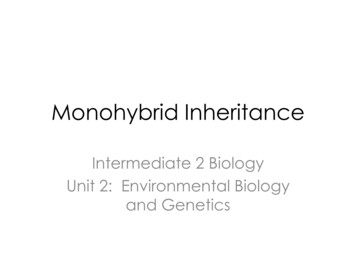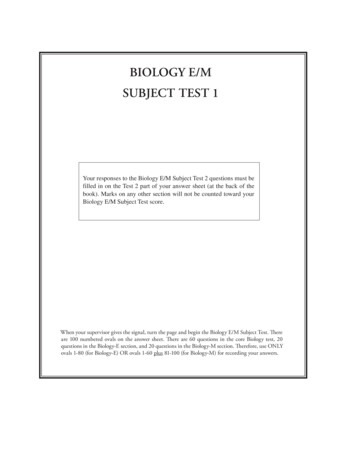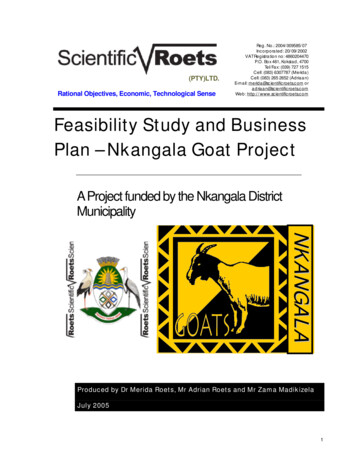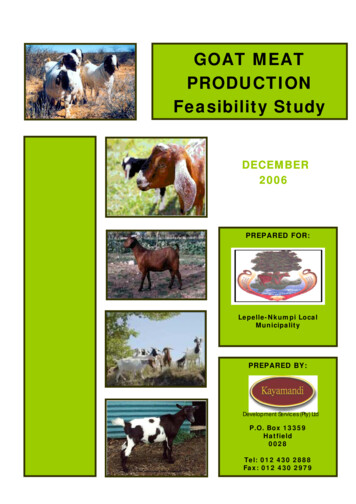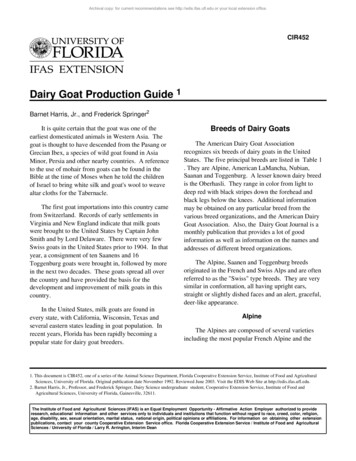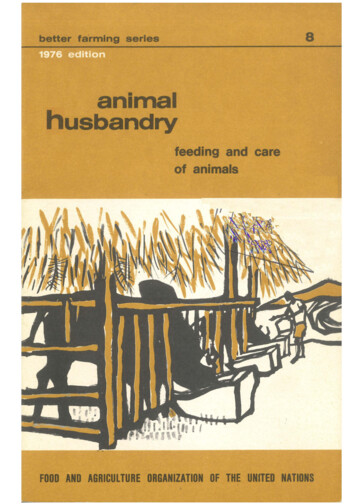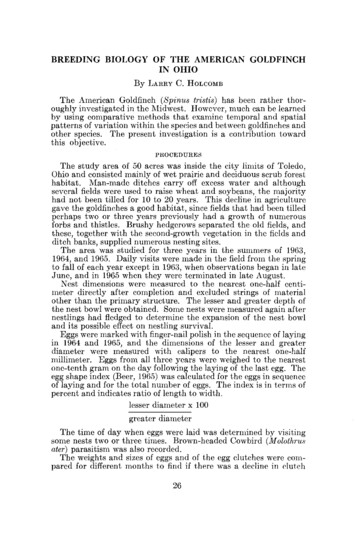
Transcription
BREEDINGBIOLOGYOF THEAMERICANIN OHIOGOLDFINCHBy LARRYC. HOLCOMBThe American Goldfinch (Spinus tristis) has been rather thoroughly investigated in the Midwest. However, much can be learnedby using comparative methods that examine temporal and spatialpatterns of variation within the speciesand between goldfinchesandother species. The present investigation is a contribution towardthis objective.PROCEDURESThe study area of 50 acres was inside the city limits of Toledo,Ohio and consistedmainly of wet prairie and deciduousscrub foresthabitat. Man-made ditches carry off excesswater and althoughseveral fields were used to raise wheat and soybeans,the majorityhad not been tilled for 10 to 20 years. This decline in agriculturegave the goldfinchesa goodhabitat, sincefields that had been tilledperhaps two or three years previously had a growth of numerousforbs and thistles. Brushy hedgerowsseparatedthe old fields, andthese, together with the second-growthvegetation in the fields andditch banks, suppliednumerousnestingsites.The area was studied for three years in the summersof 1963,1964, and 1965. Daily visits were made in the field from the springto fall of each year except in 1963, when observationsbegan in lateJune, and in 1965 when they were ternfinated in late August.Nestdimensionswere measuredto the nearestone-halfcenti-meter directly after completion and excluded strings of materialother than the primary structure. The lesserand greater depth ofthe nest bowl were obtained. Somenestswere measuredagain afternestlingshad fledged to determine the expansionof the nest bowland its possibleeffect on nestling survival.Eggs were marked with finger-nail polish in the sequenceof layingin 1964 and 1965, and the dimensionsof the lesser and greaterdiameter were measured with calipers to the nearest one-halfmillimeter. Eggs from all three years were weighed to the nearestone-tenth gram on the day following the laying of the last egg. Theeggshapeindex (Beer, 1965) was calculatedfor the eggsin sequenceof laying and for the total number of eggs. The index is in terms ofpercent and indicates ratio of length to width.lesser diameterx 100greater diameterThe time of day when eggswere laid was determinedby visitingsomenests two or three times. Brown-headed Cowbird (Molothrusater) parasitism was also recorded.The weights and sizesof eggsand of the egg clutcheswere compared for different months to find if there was a decline in clutch26
TABLE I. CLIMATOLOGICAL )ATA FORTHREE NESTING SEASONSIN TOLEDO,OHIO1963 )egrees F.Mean TemperatureTotal t ust68.567.22.038.47size or egg weight in renesting attempts or late nests. Individualbirds were not banded and, therefore, I could not distinguish thosebirds that were renesting from those that were late nesters. On afew occasions,I had reasonto suspectthat a bird was renestingnearher old nest site.Climatological data were obtained from the Toledo WeatherBureau to compare differencesin annual weather schemeswith thebreedingbiology of the Goldfinch.Statistical data are given in terms of a sample mean. The standard error and range were included to aid in interpreting populationsample trends. A two-sided Student's t-test at the 0.05 level wasused to determine whether the mean clutch sizes were significantlydifferent in the three years and whether dimensionsand indices ofeggsof known laying sequencewere different.RES 5 ,?SANDDXSCVSS O Nest BuildingIn the three years of study, 120 nestswere started, 102 were completed and 71 had full clutchesof eggslaid.Pertinent climatological data obtained from the Toledo WeatherBureau for the years in which studies were conductedare summarized in Table 1. The mean dates for the beginning of nest buildingof the first ten nests in 1963, 1964 and 1965 were 17 July, 18 Julyand 8 July, respectively. The mean dates of laying the first eggforthesenestswere 26 July, 29 July and 19 July for the three years.
28]Larry!. C.HolcombBird-BandingJanuary, 196,qThe most apparent differencesin these mean dates is the startingof nest building and time when the first eggs were laid. Goldfinchesconstructed nests and laid eggs earlier in 1963 and 1965 than in1964. The mean temperatures for June, July, and August werelower in 1963 and 1965 than in 1964 but the total rainfall was greaterin the months precedingnesting in 1963 and 1965.R,ainfall seemsto be an important factor. The years 1963 and1964 were very dry years with a total of only 22.05 and 24.28 inchesof precipitation, respectively. The normal annual rainfall forToledo is 30.50 inches. 1965 was a wet year with a total of 40.85inches of rainfall. Although 1963 was relatively dry, there wasplentiful rainfall in May and June. These are the critical monthsfor growth of vegetation usedfor food and nest sitesby goldfinches.Vegetation, such as bull thistles and Canadian thistles, grew veryslowly in 1964 and were not ready as soon for a sourceof food andnest material. Thus, goldfinchesused milkweed down instead ofthistle down for lining early nests. Batts (1948) found that whenthistle down was not available for early nests, goldfinches usedpappus of other compositesfor lining nests.Farner and Follett (1966), in an extensive review of factorsaffecting avian reproduction, report that control schemesfrom thehypothalamic level to the gonadsare similar in most species. Theadaptive significanceis in use of sourcesof information which aremost reliable for initiating reproduction when reproduction will bemost successful. Photoperiodic responseshave been studied inseveral species and for those nesting in the middle and higherlatitudes; day length has the most reliable predictive quality foronset of reproductive activity.Miller (1958) reviewed the subject of adaptation of breedingscheduleto latitude. He suggestedthat increasedrigor of requirements of photoperiod at progressivelyhigher latitudes masks orminimizes other ecologic factors which affect breeding schedule.Seasonality'other than to photoperiod was chiefly due to rainfall,the hypothesis being that perhaps the birds physiologically wereready for breeding and could reproduce quickly if sufficient rainfallprovided ample food.Tordoff and Dawson (1965) subjected the l ed Crossbill (Loxiacurvirostra) to different light regimes for 12 months. There was afailure of any of the birds to complete gonadal development. Theability of even the birds on short photoperiods (8 hours of light, 16hours of dark) to undergo partial enlargement of testes suggestedthat the Red Crossbill can reach a partial state of readinessforreproductionon any naturally occurringphotoperiod. The investigators suggestedthat the final maturation of gonadsis dependentin the wild on availability of suitable food.Kendeigh (1964) found that onset of laying in the House Wren(Troglodytesa don) was regulatedto the generaltime of year by thedevelopment of the gonads under stimulus of changing photoperiods,to the time of month by their return to the breedinggroundsfrom spring migration, and to the precise day by temperature.Nice (1937) found that Song Sparrows(Melospiza melodia)began
Vol.40,No.1BreedingoftheAmericanGoldfinch tnOhio[29nesting depending on the temperature. However, Song Sparrowsutilize different food sourcesthan goldfinches. Stokes (1950) reported that goldfinchesprobably wait until July to nest becausethe compositeswhich they feed upon do not produce adequate fooduntil that time. I have observedthe diets of nestlingsby viewing thecontents of crops through the translucent membranes. They contained mainly seeds of thistles, a few small caterpillars and occasionally insects.Baker (1938 a; b) recognized two distinct roles of periodic environmental factors. The "ultimate selecting role" exerts selectionpressureby favoring the survival of populationsthat produceyoungduring the optimal seasonof the year for survival. The "proximateinformational role" provides the internal control system of theindividual with necessary information for initiating the periodicfunctioning of the reproductive system at a time when young willbe produced in an optimum seasonfor survival.Goldfinches do not begin nesting until after the maximum daylength in June. To my knowledge no one has reported on gonadactivity of this speciesthroughout the year. I would like to suggestthat an ulthnate factor, such as production of adequate quantitiesof compositeseedsin July and August, has affected the evolution ofthe breeding seasonof the goldfinch. Stokes op. cit. also suggestedthis. The internal mechanismsof reproduction may be stimulatedby a proximate factor, such as long length of day in June and July,and then the occurrence of an adequate food source to supportadults in reproductive condition, and to feed young birds, initiatesnesting. Therefore, perhaps another of the proximate factorsgoverningthe start of breeding in goldfinchesis rainfall which promotes faster growth and production of seedsin composites.DURATIONOF TIMENEEDED TO BUILDNESTIt took lesstime to completeall stagesof nest building in Augustnests than July nests (Table 2).Walkinshaw (1938) reported that the time required for nestbuilding was about the same for early and late nests found insouthern Michigan. Stokes (op. cit.) reported less time for nestbuilding as the seasonprogressed;13 days (July 1-15), 10.8 days(July 16-31), 5.8 days (August 1-15) and 5.6 days (August 16-31).Batts (1948) reported that Margaret Drum found nest buildingtook an average of nine days with a range of six to 17 days. Sheattributed the delay to heavy rains. Sutton (1959) reported a fiveday time delay between nest completion and egg laying in one goldfinch nest. Walkinshaw (1938) found that this period was betweenone and 27 days. His average was a little over two days for mostnests.NEST MATERIALSAND SUPPORTTable 3 showsthe frequencyof use of 16 different plants as nestsupports for the different years. The panicled dogwood (Comusracewosa)and hawthorn (Crataegusspp.) were the preferred nesting
30]LarryC.Holcomb Bird-BandingJanuary, 1969
TABLE 3. PRIMARY NESTING SUBSTRATE USED BY NESTING GOLDFINCHES-FREQUENCY OF USE196319641965CombinedDataComus racemosa12114012917.17462114228Populus tremuloides21QuercusmacrocarpaAcer negundo1I.1213Prunus virginianai.12Ace7 saccharum.1Salix purpurea.JCrataegusspp.Cirsium vulgateUlmusamericana173.32l2Gleditsia triachanthosi.1Solidagospp.Malus spp.iI.lRhus typhinaP opulus grandidentataCornusstolonifera.1111l11sitesin this area. The lack of thistles in 1964 is responsiblefor theirabsenceas nest sites.The outer lining of most nestswas composedof fiber strips of drymilkweed, or other large annual plants. Down from Canadianthistles was the substanceused most often for lining nests. In therelative absenceof thistles in 1964, some milkweed seed down wasutilized. Other substancesused were rabbit hair, cottonwood catkins, fine grassesand feathers.Some nestsbuilt in late August were completely filled with thistledown and then deserteq[;no eggs were laid. When rains occurredwhile nests were being lined, the females often relined the nest withanother layer after the nest had dried. One nest had four innerlayers. In one instance on 30 July 1965, a first egg was laid whiledown was still being added. The female manipulated the egg enoughto keep it above the down.I will not elaborate on all of the different plants in which goldfincheshave been reported to nest. They apparently nest in whatever is acceptablein their geographicregion. Stokes (op. cit.) foundthat 68 percent of the goldfincheshe studied were nesting in elderberry (Sa nbucuscanadensis),and that they used these more oftenbecause they were very numerous. Walkinshaw (1938) found thelargest percent of nestsin dogwoods,(Cornusarnomumand Cornusstolonifera). His nesting area was in a swampy habitat where these
32]LarryC.HolcombBird-BandingJanuary, 1969TABL 4. MONTHLY AND YEARLY D FFERI NCES IN MEAN HEIGHTS OFGOLDFINCH IlgSTSNJuly RangeNAugustSept.196319641965CombinedData 3 92.012956.930.5-92.0392 48.660.056.553.9l . . I ange36.033.0-40.0CombinedNYearly2 .0-115.0742.631.5-62.010254.823.5-115.0*This mean value of 1963 nests is lower becauseof the use of many bullthistles as nesting sitesspeciesprobably were abundant. Nickell (1951) found the largestpercent of nestsin panicled dogwoodand the secondlargest numberin hawthorn.Height of Nest and Effect on Nest SuccessTable 4 shows the mean height of nests in July, August andSeptember and the mean height for each year. The nests for 1963had a lower mean height becauseof frequent use of thistles (Table3). There is no significant differencebetween the mean height ofJuly and August nests. Table 5 showsthere is better nestingsuccessin those neststhat are built at greater heights.Holcomb and Twiest (1968) and Meanley and Webb (1963) reported that when Red-winged Blackbird (Agelaius phoeniceus)nests were built at higher elevations, the nesting successwas muchbetter. This is probably due to keeping ground predators a vayfrom the nest. The mean height of goldfinchnestsvaries dependingon the plant community with which they are associated. Nickell(op. cit.) reported a mean height of 6.1 feet for 211 nests. Stokes(op. cit.) found an average height of about five feet and Walkinshaw(1938) found 111 nestsaveragingabout 4.3 feet up. My averagefor102 completednestswas 54.8 inchesor about 4.6 feet.Holcomb and Twiest (1968) found that Red-winged Blackbirdnests do not increase in height with progressionof the breedingseason. Nice (1937) found that Song Sparrow nests did increaseinheight as the seasonprogressed. Walkinshaw (1944, 1939 a) re-
ABLE 5. GOLDFINCH NEST SUCCESS BASED ON HEIGHT OF NEST - 3 YEARSNests Between24 and 48 inchesNestsEggs LaidYoungFledgedNests Above48 .066.351.6PercentEggsProducingFledglingsMean Heightof Nests-Inches-cordedan increasein nest height of the Chipping Sparrow (Spizellapasserina)and of the Field Sparrow (Spizella pusilla) as the seasonprogressed. Horvath (1964) and Taylor (1965) reported an increasein height of nests as the seasonprogressedfor the Rufous Hummingbird (Selasphorousrufus) and the Mockingbird (Mimus polyglottos)and Brown Thrasher (Toxostomarufum), respectively. Thegoldfinch nests appear to be lower in September but my samplesize was too small for a good comparison.NestDimensionsNest dimensions of 29 nests constructed in July (inner width,4.7 cm; outer width, 7.8 cm; inner depth 3.3 cm; outer depth, 7.4cm) were not different from 20 August and September nests (innerwidth, 4.8 cm; outer width, 7.5 cm; inner depth, 3.4 cm; outerdepth 6.8 cm). Nest dimensionsof 19 nests constructed below 48inches (inner width, 4.7 cm; outer width, 7.7 cm; inner depth, 3.3cm; outer depth, 7.3 cm) were not differentfrom 30 nestsconstructedabove 48 inches (inner width, 4.8 cm; outer width, 7.7 cm; innerdepth, 3.4 cm; outer depth, 7.1 cm). The mean height of thosebelow and above 48 inches was 40.3 and 69.3 inches respectively.Walkinshaw (1938) reported the average dimensionsof unusedgoldfinch nests as 50.25, 83.2, 35.1 and 70.6 mm for the innerdiameter, outer diameter, inner depth and outer depth, respectively.Nickell (op. cit.) reported these same dimensionsas 2.0 inches (5.0cm), 2.9 inches (7.3 cm), 1.6 inches (4.0 cm) and 2.8 inches (7.0cm). Neither of the above investigators mentioned a differenceinthe size of nests dependingon height or when they were built.Holcomb and Twiest (1968) found that Red-winged Blackbirdnests have a greater mean inner depth when built at higher elevations. They were not different when constructed early or late in thenesting season.
34]LarryC.HolcombBird-BandingJanuary, 1969Successof Nestsas a Functionof Nest DimensionSize ChangeThirteennests were measured before incubationstarted and afterthe young had fledgedto determinethe changein nest bowl sizeandits effect on successof the nest. These nests were measured only ifnestlings had left or were taken by predators when they were atleast 10 days of age. The inner depth changed very little (in 10nests there was no change) and the mean net change was 2 mm(range, --5 to - 10). The mean outer depth net changewas 8 mm(range, --20 to - 10). The mean inner depth positive changewas- i mm and the mean outer depth positive change was --3 mmshowingthat the mean inner depth stayed nearly the samebut thatthe whole nest structure was presseddown by the use of nestlingsand adults. The mean inner diameter had a positive change of 15mm (range, 5 to 25) and the mean outer diameter had a positivechangeof 12 mm (range, 0 to 30). This showsthat inner nest expansionas the nestlingsgrow is due in part to expansionand flexibility of the nest structure and alsoto compressingof the nest wall.Nests fiedgingmore nestlingswere stretchedto a greater degreethan those fiedging fewer nestlings. Those producing four or fivefledglingsstretched 15 to 20 mm but two nestlingswere crowdedoutand died and one was tossedfrom the nest by heavy wind. One nestproducing six fledglingsstretched 25 min. The nest dimensionsshould determine to some extent the nesting success,for crowdingbecomes a problem when nestlings grow larger, (Young, 1963,Holcomb and Twiest, 1968). A robin nest would be a goodexampleof one which would be inflexible, and in which crowdingcould becomecritical. The goldfinchbuilds'a more flexiblenest and usuallylays four to six eggs. As these nestlingsgrow, they crowd oneother a great deal and trample younger birds or shovethem out ofthe nest. Although the nestsexpanded,in someinstancesnestlingswere crowdedout. Nickell (op. cit.) reported an increasein dimensions of used nests. The adaptation to construction of a nest thatcan expand, the clinging habits of the nestlings mentioned bySutton (1959) and the early graspingabilities of goldfinchnestlingsreported by Holcomb (1966) probably all play a very importantrole in the success of nests.Egg LayingIn 1963, 1964, and 1965 the first nest construction began on 7July, 2 July and 5 July, respectively. The first eggwas laid on 21July, 14 July and 16 July, respectively. The date for last eggslaidis not known for 1965, but for 1963 and 1964 the dates were 23August and 7 September, respectively. Fully completed nests weresometimes deserted when rainfall prohibited normal egg-laying forseveral days. One female laid only one egg on 2 August, 1965 aftera long delay in building (started on 4 July) and waiting periodafter completion. The nest was deserted and was still intact on20 August.Batts (op. cit.) quoted Margaret Drum in saying that goldfincheswere seldoln found around the nest for three days after nest corn-
Vol.40,No.!B 'eedmgqftheAmericanGoldfinchinOhio[35pletion. I found a delay of from zero to 15 days in July with a meanof 3.4 .5 days for 38 nests and from one to five days with a meanof 1.3 .4 days for 11 August nests. The eggs are probably laidquicker in August becauseof the urgencypromoted by the development of follicles. I found that the time required in every stage ofnest building was about one-half as long in August as in July nests.When birds first begin to build nests in July, the hormones governing nesting are probably being secretedat a slow rate. There arealso many inexperiencedyoung females building for the first time.In August the hormonelevel has perhaps becomesufficientto hastennest building or birds are renesting after an unsuccessfulattemptor are building a secondnest.In 1963, one female either laid two eggsin one day or two femaleslaid eggsin the nest. I visited the nest after sunsetone evening andthere were two eggspresent. On the following day there were foureggsin that nest at 1900 and a fifth egg was present the next day.Usually, if all the eggsare taken by a predator the female abandons the nest or pulls it apart to rebuild in another location. In1965, the first two eggsof one nest were taken by a predator and thefemale did not lay the following day. However, on the next day shebegan laying again and laid a total of four additional eggs.Time of Day When Eggs Were LaidGoldfinches laid their eggs early in the morning. This wascheckedclosely only in 1965. Of 92 eggs,all were laid before 1000hours and most of thein were laid well before that time.The earliesteggwas laid before 0610. Eggs were laid early in the morning in bothearly and late nesting birds. In nest 12, egg six was laid between0614 and 0635 and in nest 18, egg three was laid between 0607 and0640. In nest 24, egg one was laid between 0630 and 0650 and eggfive between 0637 and 0710. Walkinshaw (1938) found a third egglaid before 0530. Most eggswere laid between 0600 and 0830.CowbirdParasitismIn the three years of studies only one of 102 goldfinch nestscontained a cowbird egg. This nest was found on 30 July and allfour goldfincheggshatched by 8 August. The cowbird eggremainedin the nest unhatched on 22 August after the goldfinch young hadfledged.Walkinshaw (1938) found no cowbird parasitism in 111 nests.Sutton (op. cit.) found only one nest of 61 parasitized and Stokes(op. cit.) found only one of 230 nests parasitized. Nickell (op. cit.)mentions one of his nests containing three dead cowbird young.Berger (1948) reported on two goldfinchneststhat were parasitizedby cowbirds. Undoubtedly, the late nestingseasonof the goldfinchand the earlier laying of the Cowbird in Ohio is responsiblefor thelow parasitismrate. Friedmann (1963) reportsa total of 53 instancesof parasitism on goldfinches.
36]LarryC.HolcombTABLE 6.Bird-BandingJanuary, 1969MEAN NUMBER OF EGGS PER CLUTCH IN 31 .125.03 .095-63-6Mean EggsPer Nest5.13 .124.70 .174-6Range3-6Clutch Size and Egg WeightsTables 6 through 9 show the summariesof data on egg clutchsizesand weights. Table 6 showsonly 4.70 .17eggsper clutch in1964 comparedto higher values of 1963 and 1965. The mean clutchsize in 1964 was significantly different (P .05) from thosefor 1963and 1965. The smaller number of eggsper clutch in 1964 may bedue to a scarcity of food becauseof low rainfall that year. Lack(1966) developsat length theories concerningthe effect of environmental conditionsand food supply on clutch sizes. There was nosignificant differencebetween mean clutch size for 1963 and 1965.There is little difference between clutch sizes for July (5.1 .1;43 nests) and August (5.0 .2; 25 nests). September nests havefewer eggs (4.0 eggs per clutch in three nests).Table 7 indicatesthat a three-eggclutch has larger individual eggweights. The four-egg clutches measured had exceptionally smalleggs. Five-and six-eggclutcheshad individual eggsexhibitingthesamemean weight. There was a decreasein the weight of clutchesof the same size from July to August and September.Table 8 showsthe mean eggweight of eggslaid in known sequence.Egg two weighsless than egg one. There is a gradual increaseinTABLE 8. GOLDFINCH MEAN EGG WEIGHTS - GROOMSCombinedN1964N1965NI)ataEgg 1161.34 .03121.30 .05281.33 03Egg 2171.30 .03131.28 .05301.29 03Egg 3161.33 .04131.31 .05291.32 03Egg 4161.35 .03131.35 .06291.35 03Egg 5121.39 .05141.39 .07261.39 04Egg 631.40 .0841.50 .0671.46 051.33 .0282321'1.30 0186All Eggs*Includes19631.36 .02
Vol.4 t of eggsfrom eggs three through six. The range of weightswas from .8 to 1.8 g. Two hundred eighteen July eggshad a meanweight of 1.32 q-.01 g and 103 August and September eggs had amean weight of 1.25 .02 g.Kendeigh et al. (1956) develop a hypothesis that cooler weatherearly in the breedingseasonof the House Wren stimulatesmaximumfeeding and a high level of productive energy which, in turn, permits not only heavier eggs but more of them per clutch than arepresent in later clutcheslaid in warmer weather.Since there was a significant difference between clutch sizes inthe three years of study, it is appropriate to direct attention toTable 1. The average clutch size for 1964 was significantly smallerthan in 1963 and 1965. Table i shows that in each year the meantemperature was lower for August than July although the clutchsizes for these months were nearly identical and the mean clutchweights and mean individual egg weights were less for the laterclutches. From these data, I could concludethat temperature hasvery little, if any, effect on clutch size or egg weight in the goldfinch.Stokes (op. cit.) found a mean of 4.6 eggsper clutch in 150 nestswith a range of two to seven. He found a mean clutch size in Julyof 5.3 eggsbut by late August the clutchesaveragedonly 3.7 eggs.For 10 femaleswhere first and secondclutcheswere known, Stokesfound that the first clutch averaged4.8 and the second,3.8 eggs,respectively. Walkinshaw (1938) found an average of 4.56 eggsfor62 clutches. He divided the breeding seasoninto three periods andfound an average of 4.74, 4.31 and 3.0 eggsper clutch laid before 10August, between 11 and 31 August and after i September,respectively. Sutton (op. cit.) found a mean of 4.5 for the clutch size in22 nests. I found a mean of 5.03 q-.09 eggsfor 71 nestswith a rangeof three to six. Walkinshaw (1944), Nice (1937), Meanley and Webb(op. cit.), Smith (1943) and Holcomb and Twiest (unpub.) discussedreduction in size of clutch as the seasonprogressesfor the ChippingSparrow, Song Sparrow and l ed-winged Blackbird. Walkinshaw(1938) also noticed that there was a higher mean number of eggsper clutch in the 11-31 August interval for a wetter year. Holcomband Twiest (unpub.) found that mean weight of individual l edwinged Blackbird eggsdecreasedfrom 4.35 to 4.26, 4.14 and 3.83 gfor two-, three-, four- and five-egg clutches, respectively. Nice(1937) found that eggsin four-egg setswere larger than those in fiveegg sets in the Song Sparrow. Holcomb and Twiest (unpub.) founda significant difference between the mean size of May and Juneclutch size in l ed-winged Blackbirds with fewer laid in Juneclutches. However, the eggs in June clutchesweighed significantlymore than May eggs. Allen (1914) also reported that redwing eggsbecame larger as the seasonprogressed.Successiveeggs in clutches of the domestic fowl decreasein sizeand weight (Atwood and Weakley, 1917: Bennion and Warren,1933). Nice (1937) found that in the SongSparrow, the last eggwasheaviestin 41 percent,the first eggin 29 percent and an intermediateegg in 29 percent of the cases,respectively.
38]Lar 'yC.HolcombBird-BandingJanuary, 1969TABI E9. MEAN DIMENSIONSOFGOI DFINCHEGGS(mm) ANDINDICESLesserNDiameterGreaterDiameterEgg IndexEgg 13012.816 7 .176.4 - .5Egg 22912.716 7 .176.2 .6Egg 3Egg 4303112.7 - 12.9 16 7 .l76.4 .616 9 .176.1 - .5Egg 52713.017 1 .275.9 Egg 6712.9 17 7 .372.7 4.112.816.9 .176.0 .5AllEggs161.2Kendeigh et al. (op. cit.) reported a strong tendencyfor the lastegg of the clutch in House Wrens to be the longest,widest andheaviest. In many clutches which I exanfined there was more thanone egg that was of the sameweight or dimension. Therefore,acomparisonwas made of eggsonly when one egg of the clutch washeavier,longer,or wider than any othersin the clutch. On weightbasis, 57 percent of last eggswere heaviest and 35 percent were firsteggs. When comparinglength, 92 percentwere last eggsand 8 percent, first eggs;on width, 44 percent were last eggs,and 22 percentwere secondfrom last eggsand 22 percent first eggs. This indicatesthat in the AmericanGoldfinchthe first or last egghasa tendencytobe heaviestand the last egghas a tendencyto be longer and widerthan the others.Holcomb and Twiest (unpub.) found that in the redwing, thefirst eggweighedmore than the second;then an increasein weightoccurred.The third and fourth eggswerenearly the sanhein weightand if a fifth egg was laid, it was usually smaller than the others.Table 8 shows that egg two weighs less than the first. and then asteady increasein weight is evident through egg six. Walkinshaw(1938) founda meanweightof 1.41 g for 87 fresheggswith a rangeof 1.1 to 1.7 g. I found a mean of 1.30 .01g for 321 fresh eggswitha range of .8 to 1.8 g.Egg Dimensionsand IndicesTable 9 indicates the variation in the lesserand great diameterof eggsin known sequenceof laying. There is a generaltrend foreggsto becomenarrower comparedto the length, from the first tolast eggs but no significant differenceswere found. This is alsoshownin Table 9 where mean indicesrangefrom 76.4 for eggone to72.7 for egg six but no significant difference was found.Walkinshaw (1938) reported mean measurementsof 93 goldfincheggsat 16.53 x 12.4 min. When the index is calculatedfor these 93eggsit comesto 75.02. This is very close to the value of 76.0 .2which I obtained for 164 eggs.
Vol.40,No.iBreedingof theAmericanGoldfinchin OhioTABI E 10.TIME INTERVAI FROM LAYING UNTIL[39HATCHINGAllEgg 1NX]RangeEgg 2Egg 3Egg 4Egg 5Egg 13-2212-1411-1411-13'10-13.11-13Last of clutch--All intervals were from the day the egg was laid until ithatched.*See discussion in text.Kendeigh et al. (op. cit.) reported the two last eggsof clutchesinthe House Wren are longer, broader, have a greater calculatedvolume and are heavier than the first ones laid. They found nosignificant differencesin average length, breadth, shape or calculated volumesbetween eggsin different size clutches,but largerclutches contained heavier eggs. There was less variation amongdifferent eggslaid by the samebird than among average egg characteristicsof differentbirds.IncubationPeriodFemale goldfinches were quite tame
The American Goldfinch (Spinus tristis) has been rather thor- oughly investigated in the Midwest. However, much can be learned by using comparative methods that examine temporal and spatial patterns of variation within the species and between goldfinches and other sp


